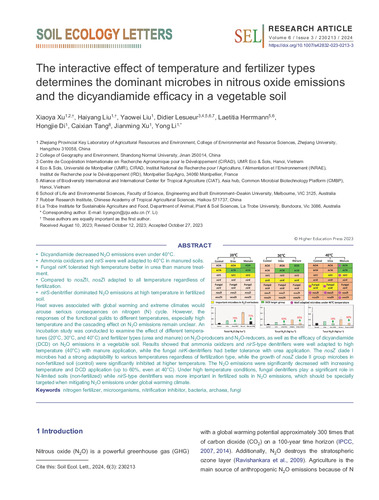The interactive effect of temperature and fertilizer types determines the dominant microbes in nitrous oxide emissions and the dicyandiamide efficacy in a vegetable soil
Heat waves associated with global warming and extreme climates would arouse serious consequences on nitrogen (N) cycle. However, the responses of the functional guilds to different temperatures, especially high temperature and the cascading effect on N2O emissions remain unclear. An incubation study was conducted to examine the effect of different temperatures (20°C, 30°C, and 40°C) and fertilizer types (urea and manure) on N2O-producers and N2O-reducers, as well as the efficacy of dicyandiamide (DCD) on N2O emissions in a vegetable soil. Results showed that ammonia oxidizers and nirS-type denitrifiers were well adapted to high temperature (40°C) with manure application, while the fungal nirK-denitrifiers had better tolerance with urea application. The nosZ clade I microbes had a strong adaptability to various temperatures regardless of fertilization type, while the growth of nosZ clade II group microbes in non-fertilized soil (control) were significantly inhibited at higher temperature. The N2O emissions were significantly decreased with increasing temperature and DCD application (up to 60%, even at 40°C). Under high temperature conditions, fungal denitrifiers play a significant role in N-limited soils (non-fertilized) while nirS-type denitrifiers was more important in fertilized soils in N2O emissions, which should be specially targeted when mitigating N2O emissions under global warming climate.

